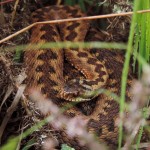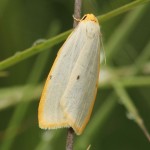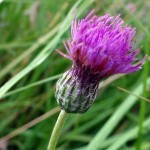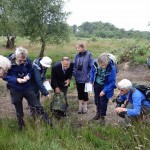On a warm cloudy day Julia Cooper led a group of 12 on a walk around Hazeley Heath. The Heath is one of the largest surviving remnants of endangered lowland heathland in the north of Hampshire. The site is designated by Natural England as a Site of Special Scientific Interest (SSSI) and is part of the Thames Basin Heaths Special Protection Area (SPA) because of its breeding population of the internationally protected Dartford warbler, Woodlark and Nightjar.
We entered the Heath from Springfield Avenue and headed north east to follow a small stream. Here we found Valerian, Cow Wheat, Alder Buckthorn, crab Apple, Yellow Loosestrife, Himalayan Balsam, Hemlock Water Dropwort and Water Figwort. On an Alder by the stream there were numerous caterpillars eating the leaves. We crossed the stream into an open field where the butterflies were just starting to fly. Here we saw Musk Mallow, Lesser Stitchwort, Greater Birds-foot trefoil, Marbled White butterflies, Small Skippers and Gatekeepers. Walking back into the drier heathland we saw Dwarf Gorse, Cross-leaved Heath, Bell Heather and Ling, both Downy and Silver Birch trees. Although most areas were very dry due to the lack of rain this year there were some small marshy areas where we saw Bog Pimpernel, Lousewort, Heath Milkwort, Dwarf Willow, Bod Asphodel, Meadow Thistle and Heath Spotted Orchids. We saw a Stonechat and Tree Pipits, Silver-studded Blues, A female Adder and a Four-dotted Footman Moth. Under a corrugated iron sheet was the skin of a dead Adder being dragged down a hole by Sexton Beetles. We walked through the woodland, then back out through the old landfill area onto heath again where we saw Green Woodpeckers feeding on dead wood, Heath Groundsel, Cudweed, Essex and Large Skippers, several Graylings, A Silver-washed Fritillary, Goats Rue and by a woodland path a Broad-leaved Helleborine.






